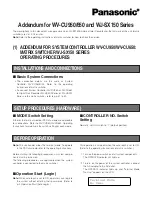
150
4B
Configuring a static CRLSP
69B
Overview
A static Constraint-based Routed Label Switched Path (CRLSP) is established by manually
specifying CRLSP setup information on the ingress, transit, and egress nodes of the forwarding path.
The CRLSP setup information includes the incoming label, outgoing label, and required bandwidth. If
the device does not have enough bandwidth resources required by a CRLSP, the CRLSP cannot be
established.
Static CRLSPs consume fewer resources, but they cannot automatically adapt to network topology
changes. Therefore, static CRLSPs are suitable for small and stable networks with simple
topologies.
Follow these guidelines to establish a static CRLSP:
•
Configure the ingress node as follows:
{
Specify the outgoing label for the CRLSP, the next hop or the outgoing interface to the next
hop, and the required bandwidth.
{
Create an MPLS TE tunnel interface.
{
Specify the static CRLSP for the tunnel interface.
The tunnel interface adds the outgoing label of the static CRLSP to each packet, and forwards
the packet to the next hop or out of the outgoing interface.
•
A transit node swaps the label carried in a received packet with a label. It forwards the packet to
the next hop or out of the outgoing interface. You must specify the incoming label, the outgoing
label, the next hop or the outgoing interface, and the required bandwidth on each transit node.
•
If it is not configured with the penultimate hop popping function, an egress node pops the
incoming label of a packet. It performs label forwarding according to the inner label or IP
forwarding. You are only required to specify the incoming label on the egress node.
•
The outgoing label specified on an LSR must be the same as the incoming label specified on
the directly connected downstream LSR.
70B
Configuration procedure
Static CRLSPs are special static LSPs. They use the same label space as static LSPs. On a device,
a static CRLSP and a static LSP cannot use the same incoming label.
A static CRLSP can forward MPLS TE traffic only after you create an MPLS TE tunnel interface on
the ingress node and specify the static CRLSP for the tunnel interface. For more information about
MPLS TE, see "
743H
Configuring MPLS TE
."
Before you configure a static CRLSP, perform the following tasks:
1.
Identify the ingress node, transit nodes, and egress node of the CRLSP.
2.
Enable MPLS on all interfaces that participate in MPLS forwarding. For more information, see
"
744H
Configuring basic MPLS
."
3.
Enable MPLS TE for each node and interface that the CRLSP traverses. For more information,
see "
745H
Configuring MPLS TE
."
To configure a static CRLSP:
Step Command
Remarks
1.
Enter system view.
system-view
N/A
















































